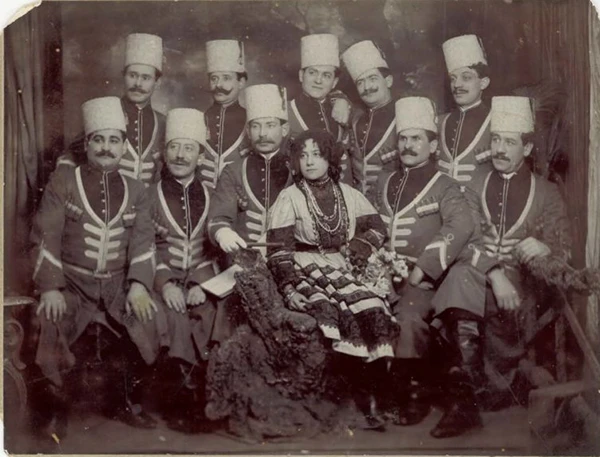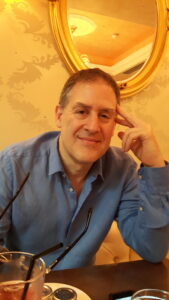Russians? Cossacks? Jews? The Russian Imperial Singers Unmasked

SOME PHOTOGRAPHS JUST make you smile, and this is one of them.
When I first saw it I thought it was a group of adults dressed up for the Jewish festival of Purim. That would explain the Cossack-style costumes and the (real or fake?) comedy store moustaches. In fact, although it’s not a Purim photo, that sense of parody and disguise is a deliberate theatrical effect.
The only member of the group whose identity is certain is the man with the woman sitting somewhat awkwardly on his lap. He’s Samuel Alman (c1877 – 1947), a distinguished composer of synagogue music whose compositions are sung to this day.
Alman was born in Sobolevka in present-day Ukraine, had a thorough musical training in the Russian Empire, and emigrated to London in the early 1900s. He has the further distinction of being the composer of the world’s first (and only?) Yiddish grand opera – King Ahaz, a Biblical epic. It premiered in Whitechapel in 1912 and did much to bankrupt the Yiddish theatre company which put it on. (Another story for another blog post).
This photograph remained with Alman and it was a relative of his who showed it to me. Handwritten on the back is a date – 1909 – the words ‘Russian Imperial Singers’ and a name – ‘Mary Bliss’ – presumably the woman sitting on Alman’s lap.
Mary Bliss has slipped through history’s fingers but I found a brief mention of the Russian Imperial Singers in the pages of the stage journal Variety from 1909. All the evidence points to the ensemble being a short-lived attraction on the London vaudeville circuit with Alman as their musical director.
In other words, we have a group of what I assume to be Jewish immigrants to London dressing up as Cossacks and passing themselves off as a vaudeville act under the patronage of the Russian Tsar.
Taken at face value, it’s a charming and ephemeral fragment of immigrant cultural history. But I think it’s possible to view the image in a wider context. To me, it points to something interesting about the nature of Jewish resilience. About the ability to adopt new identities and exploit new opportunities. And about how to survive, succeed and prosper as global actors in a pre-global age.
As Jewish immigration to Britain reached its peak in the 1890s and 1900s, politicians and popular sentiment alike struggled to make sense of the strangers in their midst. They tended to view the Jews en masse, exoticizing and exaggerating their otherness, and applying a variety of collective labels to them: Hebrews, Israelites, ghetto Jews, foreign aliens or subjects of the Tsar.
Jews themselves saw things completely differently. They were acutely aware not of their homogeneity but of their diversity. Their tribal codes, if you will, were nuanced and sophisticated. In immigrant neighbourhoods, Dutch, Russian, Romanian, Polish and Austro-Hungarian Jews crowded together, all conscious of subtle differences in dialect, food and customs. Between the various nationalities there was a clearly understood hierarchy of status and prestige: Litvaks (Jews from Vilna and elsewhere in Lithuania) looked down on Polaks (Polish Jews) who looked down on Galitsyaners (Jews from Austro-Hungarian Galicia). And as for the Romanians, well, the best that could be said about them was that they ran the best Jewish restaurants, produced great klezmer musicians and Yiddish actors, and threw great parties.
Beyond nationality, local and regional identities were often far more important than group solidarity. If you were from Vilna, Odessa or Warsaw, you might work, pray and socialise almost exclusively with fellow Jews from those cities. And religious observance, class and political allegiances further fractured the supposedly monolithic Jewish community.
This mismatch between the view from outside and Jewish self-perception made it easy for Jews to become social chameleons and engage in elaborate games of assumed identities. These adaptive and transformative strategies were often highly creative, allowing Jews to invent and reinvent themselves as they negotiated an often hostile and suspicious world.
The almost obligatory ritual of simplifying and anglicizing Jewish names was only the most obvious such device. Winogradskys became Grades; Tshizhikofs became Chiswicks, Shloymes morphed into Sams, and so on. Thousands of ordinary Jews and business figures changed their names and in some cases their biographies to pass more easily in a Gentile world.
In the world of entertainment, Jews were social chameleons par excellence. The many top Jewish magicians and illusionists were multiple masters of disguise and transformation. Houdini (real name Eric Weiss) was perhaps the most famous, but there were thousands more. One of my favourites is the remarkable Dutch Jewish Bamberg dynasty whose six generations of magicians included The Great Okito (real name Tobias or Theo) and Fu Manchu (Theo’s son David).
At various times and places, Jews made careers shape-shifting as Gypsies, Mexicans, Cowboys, and – yes – as Cossacks. In perhaps the most bizarre or imaginative twist on that particular shtik, another highly competent Conservatory-trained Russian musician, Joseph Cherniavsky, fronted a klezmer/jazz orchestra in America which switched between appearing dressed as Hassidic Jews or Cossacks.
I see the Imperial Russian Singers as fitting squarely into this tradition, riffing on the fluid and shifting nature of Jewish immigrant identity, and on the borderline between authenticity and parody.
The crossover between Jewishness and Russianness was a particularly fertile source of such improvisation. Many Russian Jews had fled Tsarist persecution, corruption and incompetence. Almost without exception they hated the Tsar and saw Tsarist rule as a byword for capricious governance and anti-semitism.
And yet, large numbers of Russian Jewish immigrants retained their Russian nationality for years, sometimes for decades. Many were fluent Russian speakers, maintained close family and trading ties to Russia and were fervent admirers of Russian culture. (When the Moscow Art Theatre came to cities like London or New York, they took out large adverts in the Yiddish immigrant press).
Before the First World War, London’s Jewish East End was full of Jewish restaurants with names like Moscow, Odessa, and Kiev. Jews made up a significant proportion of emigre Russian leftwing political parties – and Russian revolutionaries in exile were regular visitors to Whitechapel’s Jewish radical clubs.
But of course few of these links were either ‘Imperial’ or had anything to do with Cossacks. The latter were more usually identified in the Jewish collective imagination with the terrifying violence unleashed on Jewish communities during pogroms.
So, for example, the writer Manes Sperber, who grew up in a family of Yiddish-speaking Hassids in present-day Ukraine, recalled ‘a desperate flight from the advancing Cossacks’ as his family fled into the mountains:
During the nights of that long march my childhood came to a premature end and became a memory, together with….the clear eyes of Sholem Aleichem in his photograph, which the Cossacks had pierced with their bayonets during their first descent on us – a mutilation suffered by every photograph and engraving within reach.
A non-Jew going to see Alman’s vaudeville group would probably just see a group of Russian Cossacks on stage. A Jewish audience would view them with a different set of historical memories and perspectives.
Of course it could be that Alman simply heard of a job lot of Cossack costumes going cheap. But even if he did, the decision by a group of Russian Jewish immigrants to masquerade as Cossacks and call themselves the Imperial Russian Singers feels like an in-joke, a way of performing an exaggerated version of Russianness to entertain British audiences.
In our more politically correct age these things can often seem more complicated. Switching identity or impersonating another group’s identity can attract criticism or seem insensitive. But this photo of the Imperial Russian Singers reminds us that there’s often a playful side to such creative impersonation. The adoption of Cossack garb in this case seems liberating, a way of celebrating escape from oppression. A bit like dressing up at Purim.
Article Author(s)
